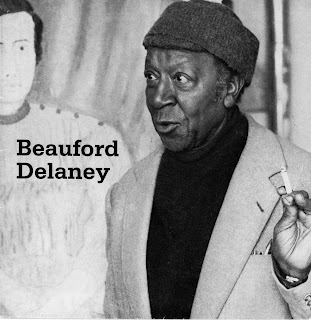This post is contributed by E. L. Kornegay, Jr., Ph. D., author of the many "re-Searching Beauford" articles as well as other posts on this blog. I consider him to be the first Beauford Delaney scholar!
************
 E. L. Kornegay, Jr., Ph. D.
E. L. Kornegay, Jr., Ph. D.
Photo courtesy of Dr. Kornegay
I have been reflecting on Beauford for quite a while now.
My first reflection was published on this site in 2011. Since then I have written a handful of short essays about my journey as I’ve searched for an understanding of Beauford. I have met a handful of people along the way, seen a handful of Beauford’s paintings, read a handful of other reflections on the work, person, and life of Beauford Delaney. A handful here, a handful there, a gathering of souls putting handfuls together offering portions of a picture of the man, the painter, the soul of Beauford Delaney – all desiring to be made whole.
I wonder, in this moment, if desire is enough to express the spaces in between the handfuls? Yes, desire is the source of both the problem and the solution to understanding Beauford as a whole. There is a desire to understand who Beauford was and the call to understand Beauford as he is. Who Beauford was is a memory held by friends, family, and admirers reminded of a history framed by maddening genius, spiritual giftedness, and human frailty. This is who Beauford
was. It is something – this history – that is indisputable for it is real to those who
knew Beauford. But what does this mean for those who want to know Beauford
now?
Beauford Delaney
Rue Guilleminot
France 1973
© Errol Sawyer*
I am not playing a game of semantics here. We know who Beauford was, but are we really willing to know who he is for us now? How do we “shake loose” the loving memory of Beauford so that we can find a new story – the story of his humanity, his blackness, his masculinity and what remains of him as an artist? How do the handfuls come together to reveal new depth, clarity and truth to who Beauford is to us now?
I have a “critical orientation” to the challenges these two perspectives pose. I believe that what gets said about Beauford Delaney today
must be said about who he is to us
now. I believe that his story can liberate those who have no one to peer into their souls and guide them into a truth they never dared to imagine for themselves. This is an embodiment of who Beauford is and should be to a new generation of youth that is “young, gifted, and black.”
There is a tangible meaning to Beauford’s life and art that intersects with the community and culture of his birth. That which extends beyond who he was and how his life is remembered must somehow circle back to the everyday folk he painted from memory. His art was his “amazing grace,” but his choice to become an artist against all odds is an amazing feat we can all learn from!
Beauford's Paint Box
© Discover Paris!
In a world where little black boys and girls get lost in a world where their gifts are often snuffed out early on, Beauford offers us a lasting memory and an ever present tangible hope for a way forward beyond the violence, injustice, and madness that unique ability encounters because of race, gender, sexuality and religion. Just like a young James Baldwin,
this generation can benefit from a “rite of passage” consisting of Beauford’s past and present, and not a moment too soon. For youth facing the dangers of dreams deferred and the real possibility of losing their lives, the handfuls of Beauford need to come together and work toward an outcome befitting his legacy.
I am going to write more about Beauford, maybe even a book. I will have to see what comes next, but I know our youth need Beauford and we need Beauford – every last handful of him –
now.
*To read about Errol Sawyer's portrait of Beauford, click
here.


















